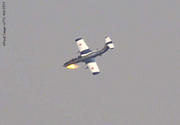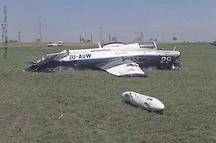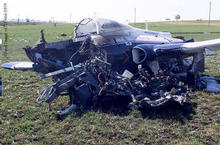Article 8
I was there when it happened and wrote an article about it.
Note: Click on the images for larges versions.
The last few seconds of the life of the L29 jet.
After the crash.
THE CRASH OF THE AERO L29 DELFIN
Coen van Wyk
The first issue of the new millennium of this magazine featured an article concerning the Aero L29 Delfin, ZU-AUW entitled, "Boys with big thundering toys". The article was in fact also the first article in the first edition of this magazine in the new millennium. Sadly this beautiful aircraft was lost during a crash that occurred during the air show at Newcastle on September 29, 2001. This article deals with certain facts pertaining to the accident.
The managing editor of this magazine, Mike de Villiers, assigned to me the task of reporting on the air show and I was flown down to Newcastle in one of Arnie Meneghelli's Harvards.
In due course the L29 arrived at the air show, parked at the dispersal area and was admired by many, which included this journalist.
The time arrived for the L29 display, with Nigel Hopkins at the controls. The commentator, Brian Emminis announced that Nigel is 29 years old and a SAA Boeing 737 First Officer. The aircraft took off and was going through its paces when Nigel suddenly declared an emergency and Brian Emminis gave an indication in his public announcement, that there is some sort of crisis concerning the L29. I was standing close to Brian Emminis at the time and from communications between him and other officials at the air show, it appeared that Hilton had made mention of a fire on board his aircraft. Brian warned the public that a particular situation was developing and urged them to stand clear of the runway.
Hilton appeared to execute a normal approach but as he passed the tower, he applied power and went around. As he approached the end of the runway the canopy was jettisoned and soon thereafter he turned to his right (away from the crowd). He continued with his turn and had completed, what appears to be close to a 180 degree turn, when the aircraft started belching fire, the left wing of the aircraft dipped, and it suddenly went into a steep dive, disappearing into the valley below. The following photograph that was taken by photographer, Frans Dely, who was assigned by SA Flyer to do photo shoots at the air show, depicts the aircraft, moments before impact.
I was stunned. This young pilot was younger than any of my three daughters, or their husbands. He had, ostensibly, not done anything wrong. Furthermore, he is a specialist, with specialist training, similar to that of a surgeon, or a nuclear physicist, or a rocket scientist, or a veterinary surgeon, or an astronaut, all of who are specifically trained to do what they can do to further the interests of mankind. In doing so, they expect rewards, but the driving force is a desire to reap rewards by doing what they can do best, and what they enjoy doing. And having seen the angle at which the L29 had entered the valley, I was convinced that he had not survived the crash.
Immediately after the crash the public address system was no longer operative and we only learned some time thereafter that that was due to the fact that the aircraft demolished the power lines during the accident.
The air show was suspended and a kind of hush came over the crowd. People continued buying their sosaties and hotdogs, but the mood was particularly subdued. However, in due course we were informed that Nigel is alive. I cannot describe the feeling of elation that I experienced when I heard that this young pilot, whom I have never met, was alive.
Frans Dely visited the crash scene and took the following photograph of the wreckage.
Frans found the pilot seat in the cockpit, in an inverted position. How Nigel escaped with his life from the crash remains a mystery.
I interviewed a number of witnesses, after the accident and the following facts emerged:
Clive Lennox told me that he was on his way to the air show when he noticed the L29 flying at low altitude and speed. He gained the impression that the aircraft was in trouble and then noticed flames coming out from underneath the front of the aircraft. While descending rapidly in a nose-up attitude, the aircraft hit a tree at the side of the road and thereafter "tumbled", as he put it, before eventually coming to rest. He added that he does not think that it went, as he put it, "end-over-end". He suggested that I speak to Winston Shoesmith and Annelie Meyer and told me that the L29 almost collided with the vehicle in which they were travelling.
When I spoke to Winston and Annelie, I was informed that they were travelling in Annelie's Citi Golf, that she got approximately a week before. Winston was driving at the time and Annalie was the one who saw the L29 bearing down on their path of travel. When she alerted Winston to that fact, he immediately applied brakes "big time", as he put it. The L29 passed over the bonnet of the Golf at a height of approximately a metre. The undercarriage was down and he thought that he saw a wheel of the undercarriage hit the guardrail on the other side of the road before colliding with the power lines. Winston said that after the aircraft struck the power lines finally came to rest on its belly. He ran to the wreckage and saw pilot lying approximately a metre from the wreckage. The pilot was conscious but appeared to have some difficulty in breathing because of all the blood on his face and in his mouth.
Dr. Mel Freese, who is in private practice in Newcastle, was the physician on duty at the air show. He said that when he arrived at the accident scene, accompanied by the fire prevention services, he found that the wreckage was smouldering, but that it was not on fire. At that stage the pilot was lying outside the remains of the aircraft. The pilot opened his eyes and spoke to Mel about the burns on his back. Mel did a thorough investigation and found that the pilot's vital signs were perfect, his airway was clear and his breathing was normal. The pilot was able to push out, with his tongue, the blood that was running down his throat. Mel specifically observed a laceration on his tongue, and lacerations on the right-hand side of his forehead, and on his left cheek. He had third degree burns inter alia on his face and legs. Mel applied a beck-brace to the injured pilot and set up an intravenous line. He later told me, with considerable pride, that it took the rescue team only thirteen minutes, calculated from the time of the accident, to deliver the injured aviator to the emergency hospital.
Jack Coetzee of Henley Air was busy giving flips in his Bell Jet Ranger III when he heard the distress signal from the L29. His brother, André Coetzee, was flipping in a Robertson 44 helicopter at the fly-in at Volksrust and they were communicating with one another when the L29 declared an emergency. Jack was was airborne in a position north of runway 29 and saw the L29 touching down on the runway and thereafter going around. The aircraft banked to the left, eventually rapidly lost altitude and after it had struck power lines, it struck the ground with its left wing struck and appeared to slide along the ground. Jack landed his helicopter and, with the help of another person that was on the scene, he pulled Nigel out of the wreckage. Nigel was conscious and actually spoke to Jack.
There has been some talk about the fact that when Nigel came in to land, after declaring an emergency, his cockpit was full of smoke, he could not see and he therefore jettisoned his canopy. I have, however, been unable to get any cogent information regarding this particular scenario.
Brian Emminis told me that the behaviour of the Newcastle spectators were outstanding. He said that he has been at air shows where accidents occurred and where the conduct of the spectators was undisciplined and dangerous. He asked me to make specific mention of the commendable behaviour of the spectators, after the accident occurred.
Finally, and on a positive note, I can report that I have been informed by Martin van Straten, the co-owner of the L29 that Nigel is now recovering and that the indications are that he will recover fully from his injuries. His lungs, which were severely infected from inhaling fumes from the burning battery and hydraulic fluid, have also cleared.


